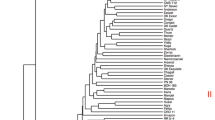Abstract
Genetic diversity among the 88 entries including eighty F4 derivatives i.e., 20 each selected from Brassica crosses viz., B. juncea × B. napus, B. juncea × B. rapa var. toria, B. juncea ×B. rapa var. yellowsarson and B. tournefortii × B. juncea, and eight parent genotypes was assessed through multivariate analysis (D2 statistic). Significant differences among the family groupsas well as within the family were recorded for all the 14 characters studied. The D2 analysis revealed enormous diversity among the interspecific cross derivatives. The genetic distances calculated among different Brassica species revealed that B. tournefortii had maximumdiversity with B. juncea followed by B. napus, B.rapa var. toria and B. rapa var. yellow sarson.Amongst interspecific crosses, maximum diversity was noticed indescendants of cross B. tournefortii × B. juncea followed byB. juncea × B. napus, B. juncea × B.rapa var. toria and the least in the cross B. juncea ×B. rapa var. yellow sarson. These results indicated that the derivatives selected from cross of diverse parents revealed greater diversity. The clustering pattern showed that many derivatives of the cross fell into the same cluster but in many cases in spite of common ancestry many descendants of the cross spread over different clusters. The characters, namely, plant height, secondary branches per plant, days to flowering and1000-seed weight were contributed maximum towards genetic divergence.
Similar content being viewed by others
References
Anand, I.J. & D.S. Rawat, 1984. Genetic diversity, combining ability and heterosis in brown mustard.Indian J Genet 44: 226–234.
Anilkumar, T.V., P.M. Salimath, P. Parameshwarappa, M.B. Chetti, S.S. Patil, A.R. Alagawadi & S.J. Patil, 1993. Genetic diversity on the basis of photosynthetic and yield related traits in chickpea (Cicer arietinum). Indian J Genet 53: 279–286.
Attia, T. & G. Roebbelen, 1986. Cytogeneticrelationship within cultivated Brassica analyzed in amphihaploids from the three diploid ancestors. Can J Genet Cytol 28: 323–329.
Bhatt, G.M., 1970. Multivariate analysis approach to selection of parents for hybridization aiming at yieldimprovement in self pollinated crops. Aust J Agric Res 21: 1–7.
Choudhary, B.R., 1997. InterspecificHybridization in Genus Brassica. Ph D. Thesis, Rajasthan Agricultural University, Bikaner, India, 185 pp.
Choudhary, B.R. & P. Joshi, 1999. Interspecific Hybridization in Brassica. Proc. 10th Int. Rapeseed Cong., Canberra, CD-ROM.
Choudhary, B.R., P. Joshi & S. Ramarao, 2000. Interspecific hybridization between Brassica carinata and Brassicarapa. Plant Breeding 119: 417–420.
Das, M.L., L. Rahman & M.A. Quddus, 1984. Correlation andpath analysis in parents and F3 of B. juncea ×B. campestris. Bangladesh J Agric 9: 1–12.
Getinet, A.,G. 0Rakow & J.P. Raney, 1995. Seed Glucosinolate Composition of Plants Derived from Interspecific Crosses of Brassica carinata ×B. juncea. Proc. 9th Int. Rapeseed Cong., Cambridge, pp. 1098–1100.
Gomez, K.A. & A.A. Gomez, 1976. Statistical Procedures for Agricultural Research. John Wiley & Sons, New York & Singapore, pp. 75–83.
Inomata, I., 1992. Intergeneric hybridization between Brassica carinata and Sinapis turgida through ovaryculture, and cytology and crossability of their progenies. Genet 11: 129–140.
Katiyar, R.P., 1978. Geneticdivergence for morpho-physiological and quality determinants of chickpea. Indian J agric Sci 49: 35–38.
Mehrotra, N., 1983. Gene-Cytoplasm Interactions Influencing Genetic Diversity in Mustard (Brassica juncea Czern & Coss). Abstr. XV Int. Cong. Genet., New Delhi, p. 567.
Mizushima, U., 1980. Genome analysis in Brassica andallied genera. In: S. Tsunoda, K. Hinata & C. Gomez-Campo (Eds.), Brassica Crops and Wild Allies, pp. 89–106. Japan Scientific Societies Press, Tokyo.
Murty, B.R. & M.I. Qadri, 1966. Analysis of divergence in some selfcompatible forms of Brassica campestris var. brown sarson. Indian J Genet 26: 45–48.
Olsson, G., 1960.Species crosses within the genus Brassica. I. Artificial Brassica juncea Coss. Hereditas 46: 171–223.
Pandey, B.P., 1980. Genetic divergence in Brassica campestris var. brown sarson. Oilseeds J 10: 3–8.
Pradhan, A.K., S. Prakash, A. Mukhopadhyay & D. Pental, 1992. Phylogeny of Brassica and allied genera based on variation in chloroplast and mitochondrial DNA patterns: molecular and taxonomic classifications are incongruous. Theor Appl Genet 85: 331–340.
Prakash, S., 1973. Non-homologous meiotic pairing in the A and B genomes of Brassica: itsbreeding significance in the production of variable amphidiploids. Genet Res 21: 133–137.
Rao, C.R., 1952.Advanced Statistical Methods in Biometrical Research. John Wiley & Sons, New York, pp. 357–364.
Rao, M.V.B.,V.R. Babu & K. Radhika, 1993. Introgression of earliness in Brassica napus L. I. An interspecific B. juncea and B. napus cross. Intern J Trop Agric XI: 14–19.
Subudhi, P.K., 1991. Widening Gene Pool for Resistance toBiotic Stress and Yield Components in Brassica juncea by Interspecific Hybridization. Ph D. Thesis,IARI, New Delhi, 188 pp.
Subudhi, P.K. & R.N. Raut, 1994.White rust resistance and its association with parental species type and leafwaxiness in Brassica juncea L. Czern & Coss 7–3 Brassica napus L. crosses under the action of EDTA and gamma-ray. Euphytica 74: 1–7.
Thakur, H.L. & M.A. Zarger, 1989. Heterosis in relation to genetic divergence andspecific combining ability in Indian mustard (Brassica juncea L. Czern & Coss). Indian J Genet 49: 223–226.
Ward, J.H., 1963. Hierarchical grouping to optimize an objective function. J Am Stat Assoc 58: 236–244.
Author information
Authors and Affiliations
Rights and permissions
About this article
Cite this article
Choudhary, B., Joshi, P. Genetic diversity in advanced derivatives of Brassica interspecific hybrids. Euphytica 121, 1–7 (2001). https://doi.org/10.1023/A:1012047107039
Issue Date:
DOI: https://doi.org/10.1023/A:1012047107039




